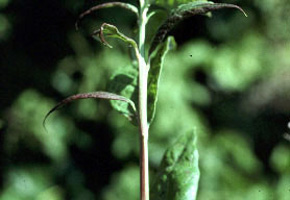Leaves are:
Yellow:
- Yellowing is interveinal, not associated with browning
- Yellowing is interveinal, associated with browning
- Yellowing is veinal, may be associated with browning
- Yellowing is splotchy, may be accompanied by splotches of pink and pale green.
Red or have red spots:
Purple or brown discoloration or spotting:
- Purple-brown spots on leaves and stems
- Purple-brown mottling may accompany crinkled leaves
- Leaves turn purple-brown at margins and are unusually narrow
Leaves are light green
Light green leaves may indicate a lack of nitrogen.
Nitrogen deficiencies are common in blueberries. Note the light green color (chlorosis) is uniform across the leaves with no particular pattern or mottling. Other symptoms of nitrogen deficiency include reduced shoot growth, numbers of new canes and yield. Nitrogen deficient leaves may develop early fall color and then drop off.
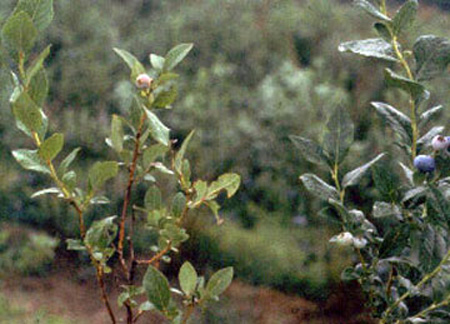
More blueberry nutrient deficiency information.
Leaves are yellow: Yellowing is interveinal, not associated with browning
Interveinal yellowing is caused by iron deficiency, but is symptomatic of high soil pH. A high soil pH (>5.2) results in the inability of the blueberry plant to use iron, causing a lack of chlorophyll production.

Iron deficiency symptoms develop first in young leaves. Lowering the pH with sulfur will usually correct the problem.

Leaves are yellow: Yellowing is interveinal, associated with browning
A number of causes can induce leaf browning in blueberries. Many of these are associated with factors contributing to overall cane death or dieback.
If canes are not dying but leaves on particular portions of the plant are turning brown, the cause could be
- Herbicide Injury
- Botrytis Stem and Leaf Blight
- Mummy Berry Shoot Blight,
- Potassium Deficiency
- Overfertilization
- Drought Stress
Herbicide injury from preemergent materials is usually accompanied by leaf yellowing or bleaching, followed by browning, and tends to be interveinal.
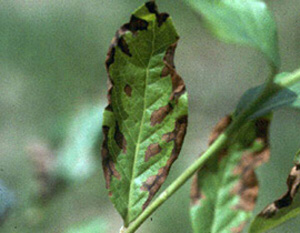
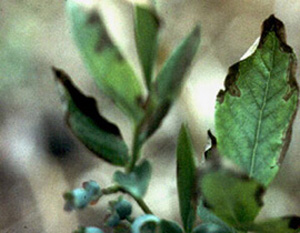
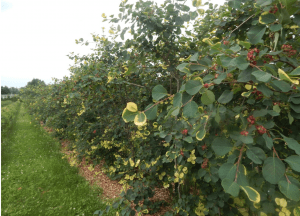
Botrytis Stem and Leaf Blight – This fungus affects leaves and shoots during damp, cool springs
More botrytis blight and fruit rot information

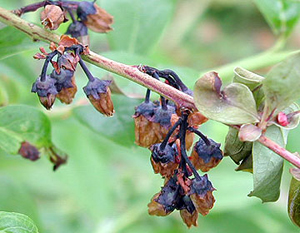
Mummy Berry Shoot Blight – Leaves become necrotic and are covered with powdery masses of gray spores during wet weather. More mummy berry information


These primary shoot blight infections occur when spores are rain splashed and wind carried from mushrooms cups developing from mummfied fruit on the ground under bushes.
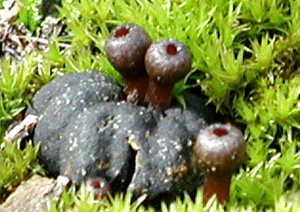

Potassium Deficiency – K deficiency results in marginal leaf burn. It is not common, but has been observed in very sandy soils.
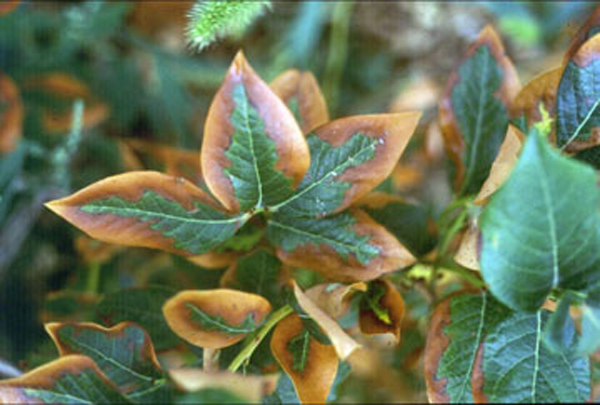
Overfertilization – Overfertilization also causes marginal leaf burn. In young plants, too much fertilizer can lead to death.

Drought Stress can cause browning of blueberry leaves. Water demand for blueberries is typically highest in the Northeast during the month of July when average precipitation is very low.

Leaves are yellow: Yellowing is veinal, may be associated with browning
Veinal yellowing or bleaching is caused by injury from Solicam (norflurazon) herbicide. More herbicide damage information.

Yellowing is splotchy, may be accompanied by splotches of pink and pale green.
Blueberry mosaic associated ophiovirus causes leaf discoloration in mosaic patterns. Leaves may be crinkled. The discoloration can vary on a single branch, from bright green leaves with irregular scatterings of pale-yellow splotches, to bright pink and yellow splotches interspersed with pale green spots.
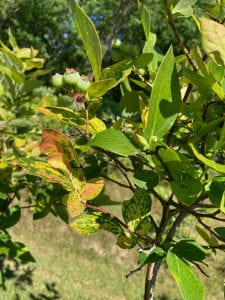
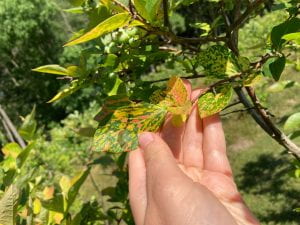
More information about blueberry mosaic associated ophiovirus.
Leaves are reddish-purple or maroon
Possible causes:
Fall Reddening – Blueberry leaves develop a maroon color in autumn as a normal response to lowering temperatures. Less frequently, blueberry leaves may develop a reddish-purplish hue in spring if the weather is cold. This coloration disappears with the arrival of warmer weather.

Phosphorus deficiency causes purple coloration in blueberry leaves, but this is rarely observed in the field. Blueberries have a low P requirement. If the pH is too high (>5.2) for adequate P uptake, other nutrients likely will be unavailable as well.

Leaves are red: Reddening is interveinal
Possible causes:
- Magnesium deficiency
- Viral diseases – Blueberry Scorch and Sheep Pen Hill Disease.
Magnesium deficiency, common in acid soils, causes interveinal reddening because chlorophyll production is reduced. Symptoms begin as an interveinal yellowing and progress to a bright red. Leaves at the bases of young shoots are most likely to exhibit symptoms first. Young leaves at the tips of shoots are seldom affected.

Viral diseases: A blueberry viral disease with similar symptoms is caused by two strains of the same virus. Blueberry scorch and Sheep Pen Hill disease (SPHD) are commonly found occurring on the West Coast and in New Jersey, respectively. Both are typically observed in spring when a blossom blight occurs. Blighted blossoms are retained through the summer but fail to develop into fruit. More blueberry virus information.
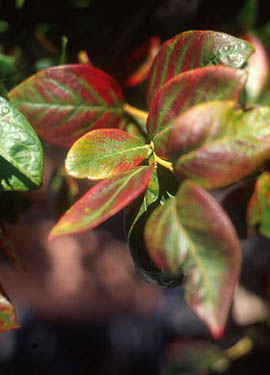

Leaves are red: Red spots are on the upper leaf surface only
Red ringspot virus causes spotting on the upper leaf surface only and on young shoots.

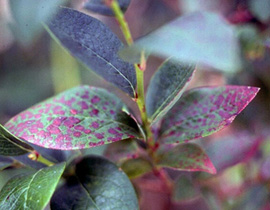


Purple-brown spots on leaves and stems
Gloeosporeum leaf spot
Gloeosporium infection, caused by the fungi Gloeosporium minus and Gloeocercospora inconspicua, causes necrotic lesions on leaves and succulent stems.
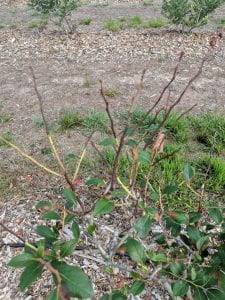
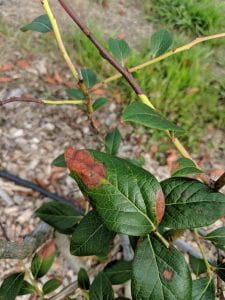
More Gloeosporium leaf spot information
Leaves are whitish
Powdery mildew:
Powdery mildew can cover leaves with a whitish “film” more commonly seen on the undersides but occasionally on the tops as well. Most commonly, though, mildew expresses itself as red or brown spots on the upper leaf surface.




Purple-brown mottling may accompany crinkled leaves
Ringspot viruses, such as tomato rinspot and tobacco ringspot virus, are so named for the spotting and mottling that can arise on infected leaves. Occasionally, infected leaves may become crinkled without obvious discoloration. Before suspecting a virus, confirm that other causes of leaf discoloration are not to blame. Viruses can only be definitively confirmed with a lab test.
More ringspot virus information
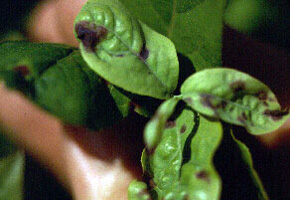
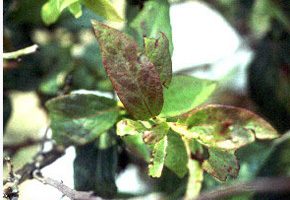
Leaves turn purple-brown at margins and are unusually narrow
Blueberry Shoestring Virus
Blueberry shoestring virus can cause straplike deformation in leaves accompanied by brown-purple discoloration. Before suspecting a virus, confirm that other causes of leaf discoloration and deformation are not to blame. Viruses can only be definitively confirmed with a lab test.
